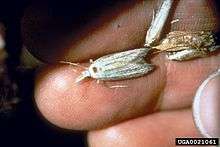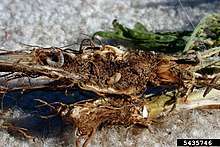Pterolonche inspersa
Pterolonche inspersa, sometimes called the brown-winged knapweed root moth,[2] is a small moth of the family Pterolonchidae.[1][3][4]
| Pterolonche inspersa | |
|---|---|
 | |
 | |
| Scientific classification | |
| Kingdom: | |
| Phylum: | |
| Class: | |
| Order: | |
| Superfamily: | |
| Family: | |
| Genus: | |
| Species: | P. inspersa |
| Binomial name | |
| Pterolonche inspersa Staudinger, 1859 | |
| Synonyms[1] | |
| |
Taxonomy
The type specimen was collected in Chiclana de la Frontera, Andalucia, Spain. Pterolonche benesignata was described from Lower Egypt by Hans Rebel in 1914.[1] The taxon P. gracilis, described by Rebel in 1916 from Crete, was synonymised to this species by Antonio Vives Moreno in 1987. In the same publication Vives placed it in his new subgenus Pterolonche.[4]
Description
The wingspan is about 20 mm, the body length is about 7 mm. Adults are light-brown without distinct markings.[2]
The eggs are oval and black.[2]
Distribution
Pterolonche inspersa is found in Portugal, Spain, France, Italy, Sardinia, Sicily, the Czech Republic, Slovakia, Hungary, Bulgaria, Greece, Crete, Turkey, Egypt and Morocco.[1][3][4] It has been found throughout most of Spain and Portugal.[4] Introduced populations have been recorded as established in Idaho (United States) and British Columbia (Canada).[2]
Ecology
In Spain there are usually two generations per year.[4] There is one generation per year in introduced populations in the northwestern United States. Adults, the imagoes, have a lifespan of only 15 to 20 days. In the US the imagoes emerge from their cocoons in June to early September. One or a small group of eggs are laid on the lower surface of the base leaves of the rosette of the host plant.[2]
The larvae feed on Centaurea species, including C. diffusa and C. maculosa. They tunnel into the root crown of their host plant and feed on the root tissue. As they reach the root cortex, they spin a silken tube and feed from within the tube. Mature larvae overwinter in the roots. In spring, a silken tube is made above the soil surface in which pupation takes place. The silken tube studded plants can be recognized as infested in the spring. The roots become spongy and plant rosettes are easily pulled from the ground.[2]
P. inspersa larvae are known to eat the larvae of the bronze knapweed root beetle, Sphenoptera jugoslavica.[2]
Uses
It was released as a biological control agent for knapweed, Centaurea species, in Colorado, Montana, and Oregon in 1986,[5] or 1988.[2] Although there was no establishment of the species in the United States initially,[5] as of 2011 it was recorded as established in Idaho and British Columbia (Canada), ten years after introduction of the species.[2]
Gallery
 Eggs
Eggs Larva
Larva Larva
Larva Larva
Larva Adult
Adult
References
- Savela, Markku (24 August 2017). "Pterolonche". Lepidoptera and some other life forms. Retrieved 29 December 2019.
- "Pterolonche inspersa". BugWood. Center for Invasive Species and Ecosystem Health, University of Georgia. 19 January 2011. Retrieved 29 December 2019.
- "Pterolonche inspersa Staudinger, 1859". Fauna Europaea. Fauna Europaea Secretariat, Museum für Naturkunde Leibniz & Institut für Evolutions- und Biodiversitätsforschung. Retrieved 29 December 2019.
- Vives Moreno, Antonio (27 February 1987). "La familia Pterolonchidae Meyrick, 1918, de España y Portugal (Insecta, Lepidoptera)" (PDF). Revista Española de Entomología (in Spanish). 62 (1–4): 319–337. Retrieved 26 December 2019.
- "Pterolonche inspersa". Weed-feeder. Department of Entomology, Cornell University. Retrieved 25 August 2011.